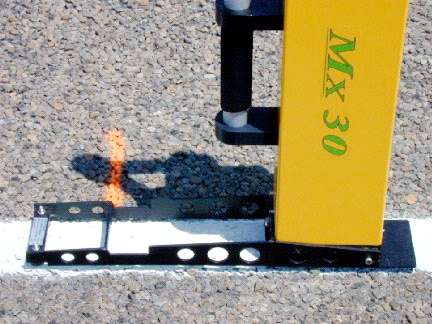Nighttime Appearance
Nighttime appearance of pavement markings is critical to roadway navigation at night. The two critical components of nighttime appearance are nighttime color and nighttime brightness. Discussions follow.
Nighttime Color.
Depending on the pigments, the nighttime color of pavement markings may appear to be significantly different from the color during the day. This difference is due to the differences in the illumination characteristics between night (headlamps) and day (sunlight) driving. Yellow markings are especially susceptible to having a different color appearance at night. Although not usually a problem in lead-containing thermoplastics, yellow markings containing lead-free pigments have been known to appear whiter at night compared to daytime. Although TxDOT does not currently have a specification for measurement of nighttime color, visual inspection of the color at night provides assistance in future product decisions.Nighttime Brightness.
The brightness of pavement markings at night is influenced by a number of variables, some of which are independent of the pavement marking itself. Factors that are external to the pavement marking include: headlamp aim and intensity, weather conditions (rain, snow, fog), and visual capabilities of the driver. The characteristics of the glass beads are the primary influence in nighttime brightness within the marking itself.Nighttime brightness of pavement markings can be estimated during the striping operation using one of the following two methods:
- performing the sun-over-shoulder test
- measuring marking retroreflectivity and comparing the values to minimum specifications.
Discussions of each method follow.
Sun-over-Shoulder Test for Nighttime Brightness.
The sun-over-shoulder test is described in Test Method
“Determining Functional Characteristics of Pavement Markings.” The highlights of this test method are described in Table 3-5. This method is only to be performed when the sun is 20 to 80 degrees above the horizon. Using this method, if the beads are properly embedded and dispersed, the line will have a vibrant and uniform glow. Figure 3-5 shows an example of the sun-over-shoulder test.Step | Action |
|---|---|
1 | When the sun is 20 to 80 degrees above the horizon, position yourself so that the sun is behind you. |
2 | View the stripe in front of you along a plane parallel to your shadow. |
3 | Adjust your distance from the stripe to where the shadow of your head touches the stripe area being observed. |
4 | From this position, evaluate the retroreflective qualities of the stripe. |

Figure 3-5. Sun-over-shoulder test from Test Method Tex-828-B.
Measuring Marking Retroreflectivity to Determine Nighttime Brightness.
Marking retroreflectivity is measured with a portable handheld retroreflectometer and then compared to the values to TxDOT minimum specifications for retroreflectivity of new pavement markings. Figure 3-6 shows an example of a retroreflectometer that is prepared for measurement.
Figure 3-6. Handheld instrument prepared for retroreflectivity measurement.
Results of Nighttime Brightness Measurements.
Notify the operator immediately if the markings are not passing the nighttime brightness measures. In some cases, instrument measurements may not provide an accurate measurement of the actual retroreflectivity of the marking. This disparity typically occurs where the surface is not flat (i.e., when the marking is located on a steep crown or joint in the concrete). Care should be taken when selecting a location to take retroreflectivity readings. Whenever possible, retroreflectivity measurements should be made where the pavement surface is flat.